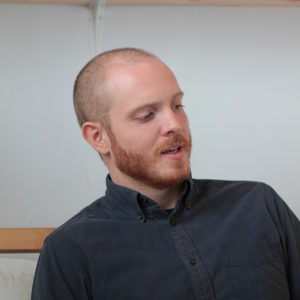Blog
GRINDR UBER AIRBNB – JONATHAN CHOMKO
I have a friend who recently returned to Instagram; he had kept away, he said, because he didn’t like how being on the platform changed his everyday life. As he moved through the world, he would catch himself noticing objects and scenes that would make good posts, the frame of Instagram now a part of his cognition.
We reach into software, and it reaches back into us, shaping how we engage with the world.
In www.grindruberairbnb.exposed (GUA) I explore this relationship between user and interface, through a series of interactions that require physical gestures to complete. As a group of people visit the website together from their phones, they are led through a series of gestures and movements which bring the group in and out of sync. Through this guidance, a sense of collective cohesion develops in the group.
GUA is an exercise in making explicit the power dynamics of an interactive system; the menu is stripped back to one option, to engage with the system is to fit one’s expression into the interfaces provided.
The title combines the names of three digital services which direct flows of bodies, vehicles and real estate through the physical world. Condensing these network-scale movements onto a stage, GUA brings into view the idea of a system as a whole, an evocation of Uber’s early-day ‘god view’; a real-time interface showing the movement of cars and customers deployed as entertainment at launch parties.
GUA demonstrates the potential for the network to coordinate action; across a city thousands are linked together through invisible threads, occupying the same platform without a view of each other. GUA echoes this siloing; the god view of their collective gesture is visible only to the audience; the participant/performers can only sense their collective cohesion through movement.
In A Heart From Space, participants are given a shared god view; each user sees their and the group’s GPS positions on a map, a line encircling all points. Rather than providing discrete instructions as in GUA, users move autonomously towards the collective goal of drawing a heart. Collaboration happens through this top-down view, each user moving in response to the collective, taking their place in and refining the shape of a heart.
The majority of our digital experiences follow the path of GUA; we receive a feed tailored to our interests; the sentiments of others visible only as numbers. We can see glimpses of the collective view when buying ads on Facebook; in these interfaces, users are clustered into pools of affinity; one can target life events such as the marriage of a friend, having recently left one’s hometown, a recent breakup, and in any combination.
There is no mechanism on Facebook to translate these collective affinities into collective action; each person who recently experienced a breakup is on their own in their stream, unaware of the many others who are experiencing the same event at the same time.
We walk around with the equivalent of the Library of Alexandria in our pockets, but we choose to spend our time checking our social status. How much of this is due to our predilections, and how much is due to the views we have available to us? My estimation is that our systems nudge us more than we like to admit, and that new and better systems could nudge us to new and better places.

Jonathan Chomko is an artist working with and against technology. His works examine the seam between physical and digital worlds, exploring how digital forces translate into and act upon the physical world, and how physical phenomena and expression are modulated as they enter the digital.








